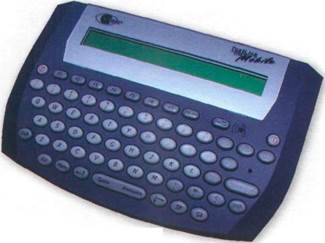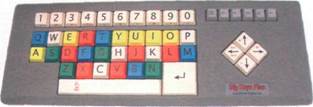Computers for the disabled
Computers have taken a dominant role in our society, meaning most jobs now require access to computers and the Internet. But what happens if a person is blind, deaf or motor-disabled? They needn't worry. The latest assistive technology is designed to help them use computers and do their jobs in the office, learn at school, or interact with their families at home. In addition, new laws oblige companies to adapt the workplace to accommodate disabled people. For example, the Americans with Disabilities Act (ADA) and the UK's Disability Discrimination Act make it illegal for employers to discriminate against people with disabilities.
To work effectively, most blind users need to have their computers adapted with technologies such as Braille, screen magnifiers, speech synthesis and Optical Character Recognition (OCR).
Braille keyboards have Braille lettering on keyboard overlays, allowing the blind user to easily identify each key. For output, there are printers, called Braille embossers, that produce tactile Braille symbols on both sides of a page at high speed.
For someone with limited but usable vision, a screen magnifier may be appropriate. This type of software can enlarge text and images appearing on the screen by up to 16 times.
 A Braille embosser prints a hard copy of a text document in Braille
A Braille embosser prints a hard copy of a text document in Braille
|
A speech synthesis system is used to read aloud the work on the computer. It has a speech synthesizer, which produces the audio output, and a screen reader - the program which reads aloud text and menus from word processors, databases and the Web.
OCR uses a flatbed scanner and specialized OCR software to read printed material and send the text to the computer. The PC can then produce a copy of the text in Braille, a magnified copy, or a version that can be read aloud by a speech synthesis system.
Deaf computer users can overcome many communication difficulties with the aid of visual alerts, electronic notetakers and textphones. Visual alerts are indicators that alert the deaf user when they receive new mail or when there is a system error. So instead of hearing a sound, the user is alerted by a blinking menu bar or by a message on the screen. Electronic notetakers use software that types a summary of what is said in meetings onto the computer screen.
Textphones allow the deaf to type and read phone conversations. They are also called TDDs (Telephone Devices for the Deaf) or TTYs (TeleTypewriters). They can be used in combination with relay services, where an operator says what the text user types, and types what a voice phone user says. Deaf people can also communicate via SMS and instant messaging.
 A textphone
A textphone
|
Motor-impaired workers unable to type on a standard keyboard can employ expanded or ergonomic keyboards, on-screen keyboards, adaptive switches and voice recognition systems
On-screen keyboards are software images of a keyboard that appear on the screen and may be activated with a trackball, touch screen, screen-pointing device, or eye movements. In an eyegaze system, the keys on the virtual keyboard are activated by the user's eyes when they pause on a key for two or three seconds.
 video camera
Eyegaze technology consists of a video camera and image processing software, which determines the eye's gazepoint on the screen
video camera
Eyegaze technology consists of a video camera and image processing software, which determines the eye's gazepoint on the screen
|
Switches come in many shapes and sizes. They are operated by muscle movements or breath control. For example, a pneumatic switch - known as a sip and puff
- allows someone with quadriplegia to control the PC by puffing and sipping air through a pneumatic tube. People with quadriplegia can also use sip and puff joysticks.
Finally, there's voice recognition, which allows the computer to interpret human speech, transforming the words into digitized text or instructions.
 A specialized keyboard for children with physical disabilities
A specialized keyboard for children with physical disabilities
|
Deviccs for the disabled
ВComplete the crossword with words from the text on pages 43-44.
| 2 An |
ACROSS
keyboard presents a
graphic representation of a keyboard on the desktop screen and allows people with mobility impairments to type data using a joystick or a pointing device.
Visual.................... allow deaf users to be
notified of incoming mail or error messages without hearing a tone.
A screen____________ makes the computer
screen more readable for users with poor vision.
A system of reading and writing using raised dots, which enables blind people to read by touch.
DOWN
1 Unlike a standard telephone, a
small screen and a keyboard that transcribes a spoken voice as text. It is used for text communication via a telephone line, ideal for people who have hearing or speech difficulties.
A Braille____________ is an impact printer that prints
| screen |
| adjective present participle 's genitive noun |
| ВExplain the noun phrases in A. Example: disabled worker = a worker who is disabled |
text as Braille, by punching dots onto paper. A speech synthesizer is used in conjunction with a
to convert screen contents into
spoken words.
Language work: noun phrases
ALook at the HELP box and then the noun phrases 1 -6. Decide what type of modifier (a-d) is placed before the 'head' in each case.
1 disabled worker a
2 rehabilitation engineer b
3 employee's abilities с
4 adapted keyboard d
5 voice-activated computer
6 pointing device
A noun phrase is a phrase that has a noun as its head. This noun can be accompanied by a modifier that gives information about the head.
modifier head
speech recognition compatible computer
A noun phrase can function as the subject or object of a verb. It can contain the following range of modifiers:
• adjectives
I have a portable computer. = a computer which is portable
• present participles
I use this drawing program. = a program that draws
• 's genitive
The files are on the director's computer.
= the computer which belongs to the director
• nouns

|
| has a |
| • I* |
| Noun phrases |
I need to buy a colour scanner. = a scanner which uses colour
Assistive technologies for the blind
Cl,Listen to an interview with Mike Hartley, the director of the Assistive Technology Project for the Blind in Washington DC. Make notes about these topics.
 /4 Braille computer keyboard
/4 Braille computer keyboard
|

|
I The ioCxU that Mllte IS currently Involved In-.
2. Assistive technologies for blend users
3 The difference beti^ieen voice recognition and Speech SynbheSlS'
4- The aoal of the U)eb Accessibility Initiative
S Companies developing assistive technology products'
Small-Talk Ultra, a talking computer from GW Micro, which includes Window-Eyes - a screen reader for the blind
В &In pairs, help each other to improve your notes and then listen again to make sure you have included all of the important information.

|
Investing in assistive technologies
Your school/company has decided to invest some of its annual IT budget in assistive technology. Write an email to your director of studies / manager, summarizing the different technologies available and the kind of people they can help. If possible, use the Internet to find suppliers of these technologies in your country.
Now visit www.cambridge.org/elt/ict for an online task.